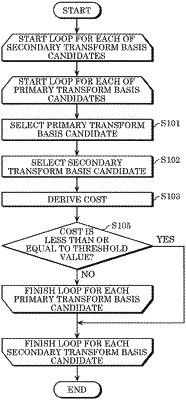| CPC H04N 19/12 (2014.11) [H04N 19/14 (2014.11); H04N 19/147 (2014.11); H04N 19/176 (2014.11); H04N 19/46 (2014.11); H04N 19/61 (2014.11); H04N 19/65 (2014.11); H04N 19/119 (2014.11)] | 5 Claims |

|
1. A decoder comprising:
a processor; and
a memory,
wherein the processor, using the memory:
inverse quantizes data corresponding to a current block of an image;
performs an inverse secondary transform, using one candidate of the inverse secondary transform selected from candidates of the inverse secondary transform, on a result of the inverse quantization to generate second transform coefficients, the candidates of the inverse secondary transform including transform bases for the inverse secondary transform and a skip of the inverse secondary transform; and
performs an inverse primary transform, using one candidate of the inverse primary transform selected from candidates of the inverse primary transform, on the second transform coefficients or the result of the inverse quantization to generate first transform coefficients, the candidates of the inverse primary transform including transform bases for the inverse primary transform, wherein
a fixed second candidate is always used for the inverse secondary transform in response to a case of a selected candidate of the inverse primary transform being other than a fixed first candidate, and
the fixed first candidate is always used for the inverse primary transform in response to a case of the selected candidate of the inverse secondary transform being other than the fixed second candidate.
|